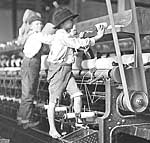Activity 2: Skills and Best Practices
Using Pictures and Drawings to Teach Social Studies
The use of pictures in helping students understand a concept is connected to the research on brain compatible teaching. For example, Corn Associates incorporate the following strategies into their training programs. Brain compatible teaching strategies include:
- Beginning a lesson with a focus on a core concept connected to student's prior knowledge
- Creating meaning by using fictional and informational literature and interdisciplinary teaching.
- Asking higher order questions that require students to apply, compare, create, predict, and judge information.
- Using visualizations such a drawings, sketches, pictures, charts, guided imagery, and metaphors.
All of these strategies are essential components of this module.
Using Photographs to Teach Social Studies
The U. S. National Archives and Records Administration suggests three steps to help students analyze photographs.
Step I: Observation
- Overall impressions
- Details in each section of the photo (people, objects, activities)
- What can you infer from the photograph?
- What questions does the photo raise in your mind?
- Where could you find answers to your questions?
They also offer a Photo Analysis Worksheet on their website.
Graphic Organizers
Graphic organizers are valuable instructional tools. Unlike many tools that just have one purpose, graphic organizers are flexible and endless in application. One common trait found among graphic organizers is that they show the order and completeness of a student's thought process - strengths and weaknesses of understanding become clearly evident. Many graphic organizers show different aspects of an issue/problem - in close and also big picture. Since many graphic organizers use short words or phrases, they are ideal for many types of learners, including English Language Learners with intermediate proficiency.
Although five main types of organizers are mentioned in this piece, many others exist, or will soon be created.
This site will provide some excellent examples of graphic organizers.
Problem-Based Learning
One of the goals of social studies is the creation of students who are effective problem solvers. Information is of little importance to students unless they are able to use that information to solve problems and make decisions. Problem-Based Learning, a curriculum development and delivery system, recognizes the need to develop these skills in children. This site focuses on these key areas:
- Problems drive the curriculum
- Problems do not have only one solution
- Students solve the problems
- There is no one approach to a problem
Performance-based assessment is an integral part of the process.

 Module Menu
Module Menu Printable View
Printable View